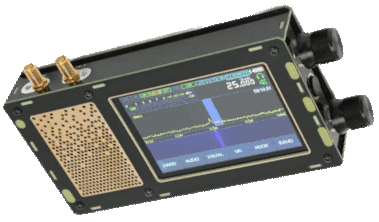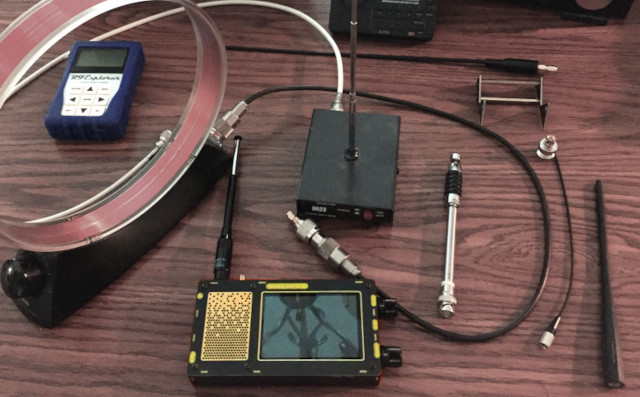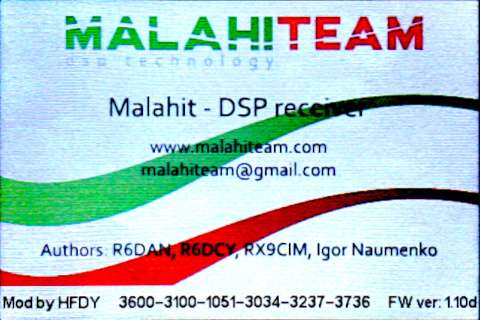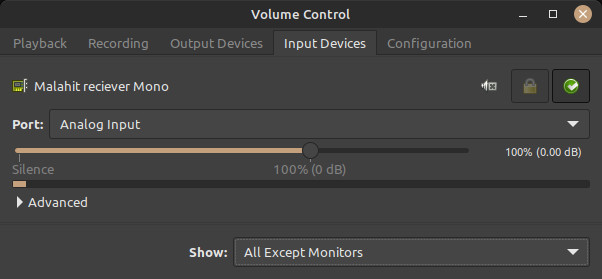HFDY Malahit DSP SDR v3
Malahit DSP SDR V3 50KHz - 2GHz DSP SDR Receiver. This is an all-in-one portable SDR that is controlled via a touch screen and two encoders. In a review it was concluded the quality of the HFDY unit exceeds that of the Russia-made DSP-2.
New V3 Malachite Radio Dual Antenna Latest Version 1.10D Malahit-DSP Stereo Portable 3rd Version SDR Receiver 50KHz-2GHz
- Based on the SDR architecture, the msi001 radio frequency front-end 12bit quantization sampling is adopted, and the processor adopts STM32H743, the main frequency is up to 480 MHz;
- The receiving frequency is 50kHz to 49.999MHz, 50.001MHz to 249.999MHz, 400MHz to 2GHz;
- Demodulation type: AM, SSB, NFM, WFM, CW;
- Sensitivity is better than 0.2-0.3μV;
- Anti-blocking is better than 85 dB;
- Real-time sampling bandwidth is 160 kHz;
- Function: variable filter, adaptive noise reduction, threshold noise reduction, noise suppressor, AGC, equalizer, etc.;
- Display screen is IPS 3.5 inches, capacitive touch screen with backlight adjustment;
- The battery capacity is 3000mAh, USB-TYPEC interface;
- The working current does not exceed 300mA;
- Optional front-end attenuation filter components, attenuation up to 30dB;
- Connect to the computer via USB, which can realize CAT, IQ and audio communication;
- The size of the whole machine is 147×77×25mm.
The HFDY Chinese model is advertised as: HFDY Registered 50K-2GHz V1.10d Malahiteam SDR Receiver Radio DSP SDR Receiver 3.5" Touch LCD with Code support Two Antenna V3
Software Activation: HFDY arrives with already activated software.
This SDR unit is _not_ well documented. Information is sketchy at best. Information will be added here as it becomes available via our own testing and from other sources. Our first goal is to document general operation of the device.
Contents
Basic Usage
power on volume, and tuning
- short press the power button (between the two encoder knobs) to power the unit on
- short press again to power save - turns off LCD
- long press the power button to turn the unit off.
encoder scanning is hit and miss: what this means is that sometimes when you press or turn a control the radio will not react. this is a deficiency in the software. do not give up or assume it is defective. simply continue to turn the encoder or try tapping the LCD a bit longer.
volume encoder modes: the top encoder knob not only adjusts volume, but also does other functions. volume encoder functions
- attenuator - adjust sensitivity of reception
- volume - loudness
- filter - narrow, normal, and wide to filter out adjacent signal (impacts sound quality)
- function indicated in top right of LCD
the tuning encoder adjusts the frequency in steps you can define
- short press tuning encoder to adjust tuning frequency steps. for FM broadcast set to 1.0 MHz.
- long press the tuning encoder to lock the tuning frequency
other ways to tune: using the LCD touch screen
- tap the frequency indicator on the LCD screen to manually enter a frequency (ensure tuning is unlocked)
- tap the spectrum display to adjust frequency in small increments
adjust modulation mode (AM, FM, SSB, etc...)
- tap the mode visual key 5th on the bottom row
Example: Tuning in an FM broadcast station, setting correct modulation, filter, and mode. Example, tune in 101.9 FM
- tap the frequency display and enter 101.9 then tap Mhz
- tap the MODE softkey on the bottom row and select WFM (wide frequency modulation)
- tap the MODE softkey again to return to normal display
- short press the volume encoder until FILTER is selected (to the right of volume) and set to FLT WIDE
- short press the volume encoder until ATT is selected and set to 0 or increase attenuation if you are in a strong signal area
- short press the volume encoder to return to volume function
If you're still not able to tune a station you should perform basic troubleshooting such as making sure the correct antenna SMA connector is active, and perhaps one of the many other functions is not the culprit. This is not a toy for beginners, do not assume it is defective if you at first have difficulty.
two antenna connectors
Each of these sma connectors has an LED indicator next to it that shows whether that particular antenna is being used, either 50 ohm or Hi-Z. If you have the HDFY Chinese version you will notice that both may remain connected at the same time.
- You can attach the whip antenna or sma antenna to the first connector 50ohm to use for basic reception, such as in our example above where we tune an FM broadcast station.
- attaching an antenna such as a magnetic loop for medium and short wave reception works well n the hi-z sma connection
The unit allows you to configure which antenna connection is active for a frequency or preset although there are some defaults. To chance the active antenna SMA connection:
- tap the HARD softkey which is first in the bottom row on the LCD
- locate the box labeled "SW antenna" (should be second row top) and tap to toggle between "50 Ohm" or "Hi-Z"
- tap the HARD box again to return to default display
The difference between the two connectors: Both are identified by their impedance. The first is 50-ohm, the common impedance used in the two-way radio world such as on amateur radio equipment. The second labeled Hi-Z refers to "High Impedance" and is suitable for things like long wire antennas and magnetic loop antennas. (simplification) You will get the best mileage utilizing the 50-ohm SMA for tuning frequencies in the VHF band and above. The Hi-Z or high impedance SMA connection is more suitable for frequencies in the HF spectrum including shortwave radio. You can have antennas connected to both at the same time and make the selection via the radio interface.
HFDY clone in comparison with the Russia-made DSP-2
There is one primary online source for a review comparison of the two radios. It is the Dan Robinson comparing Russian Malahit DSP-2 to the Chinese clone article which has been copied and reproduced on a number of different web sites. In summary the review concludes:
The original Malahit DSP-2 from "Malahiteam" is a portable SDR with built in speaker and touchscreen. It has a frequency range spanning between 50 kHz to 50 MHz, 50 MHz to 250 MHz and 400 MHz to 2 GHz. The Chinese "HFDY V3" clone appears to be superior in terms of build quality with its metal construction, solid metal knobs, dual SMA antenna connectors, additional internal shielding, and front firing speaker. It also has a styled golden speaker grill. These are all improvements over the Russian made version, however it's important to note that the Chinese clone version comes with older firmware. It is possible to update the firmware to the latest version released by the Russian designer, however, the process can be somewhat risky.
Dan Robinson performed the firmware upgrade on his unit and concludes there is no difference in performance between the two. Dan goes on to mention that both the clone and original firmware do not address the unit's grounding sensitivity, which is a product of the metal case and noticeable with limited antenna.
Our Review
This will be a work in progress as we have only just begun to examine the unit. Firstly, the reception sensitivity is impressive on the HF spectrum. We tested shortwave radio reception on a small magnetic loop and compared to a number of consumer shortwave radios. What was most unexpected was our ability to filter out QRM / interference. There is a lot or radio noise in an urban setting and in many modern homes. We actually had more difficulty with interference on the dedicated consumer shortwave radios than we did on the HFDY Malahit SDR.
The little whip antenna that is shipped with the unit is pretty useless. For better VHF reception there are a number of antennas available in the ham radio HT category with sma connection as well as some good quality telescoping antennas. Another option is a quality scanner antenna, although they typically have a BNC connector thus the requirement of an adapter. We replaced the whip with a basic and lightweight telescoping antenna of reasonable length with very positive results. The larger the antenna the better (more metal, more signal) however keep in mind that you do not want to put a great deal of stress on the sma connector of the unit. Perhaps an "active antenna" with sma cable connection as a separate stand alone unit is a good idea. For 2-meter amateur radio reception we had best results connecting to an outdoor antenna such as a J-pole.
The sound quality of the HFDY Malahit SDR was also surprising, it actually sounds pretty good. On reception of FM broadcast on WFM stereo the sound quality of the tiny internal speaker was more than antiquate. Next we will connect the line-out to a hifi amplifier to satisfy our curiosity. AM broadcast reception and audio quality is also impressive.
Connecting a grounding wire to the unit can improve reception. If you are listening to shortwave radio, for example, and you release the unit from your hand you may notice considerable signal degradation. Adding a grounding wire attached to the metal case or near the antenna connector can act as a counterpoise with the necessary length depending on the frequency range being monitored and the attached antenna. Providing a good RF ground will increase reception of HF frequencies.
upcoming tests
- monitoring local VHF ham repeaters
- FLDigi and rig control
- P25 decode via computer
Firmware
Determine Version
How do you find out the firmware version: When you first power the unit on, by long pressing the power button, the initial screen will offer information including the current firmware version.
Versions Compared
The HFDY Malahit SDR V3 firmware is adequate and offers most of the features that are important in comparison with the Russia-made DSP-2.
- 1.10c Firmware on Chinese Clone
The HFDY SDR uses 1.10c firmware whereas the Russian-made DSP-2 uses the latest official 2.10D firmware.
The Chinese-made HFDY leaves out a large portion of the military AIR band, with no coverage from 250MHz to 400MHz, or about 150MHz, whereas the Russian-made DSP2 only loses 20MHz from 380MHz to 400MHz.
Howto Update
Users have successfully flashed the latest Russian firmware on the Chinese HFDY unit. Caution! It is risky to flash the firmware as a failure in the flash process could render the device completely unusable without a recovery option.
How to upgrade the firmware. The dfu-utils package on Ubuntu and similar distributions is installed by typing:
sudo apt install dfu-utils
there's more... (a lot more)
MalahitSDR on Reddit
New firmware releases are discussed.
PC Connection
The Malahit SDR will not charge off the computer USB port if the Malahit SDR is not powered on. When powered on, it will both charge and connect to the PC as an external sound card. It appears as an external sound device. It is capabile of both input and output sound. When connected it will appear (address may vary) as:
Bus 003 Device 112: ID ffff:0737 MicroGenSF Malahit reciever
It is visible in PulseAudio Control
The audio is available for capture and recording using software such as Audacity. In order to hear the audio from the capture device you will need a loopback module active, same as if you wanted to monitor the audio on your live microphone.
Module should automatically create loopback outputs for available input devices. To load the module manually
pactl load-module module-loopback
To make the change persistent, append /etc/pulse/default.pa with
load-module module-loopback
To stop it running, run:
pactl unload-module module-loopback
Loopback quality is poor for some reason, there is a timing issue.
The Malachite-DSP also supports CAT and IQ connections to a host PC. The Malachite-DSP "borrows" the CAT (Rig Control) profile of a Kenwood TS-480. When the Malachite-DSP is connected to the Linux computer via USB, it creates several serial ports such as:
- /dev/ttyACM0
- /dev/ttyACM1



